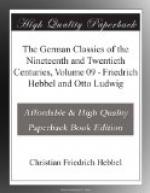story may indeed be taken as a symbol of that principle
of “poetic realism” which Ludwig strove
for and of which the story is one of the best embodiments.
The technique of the work, to be sure, is that of
Ludwig’s day, not of our own. There are
long descriptions and reflections and a good deal
of direct psychological analysis, in all of which
the narrator does not hesitate to speak from his subjective
point of view. Such a method modern theorists
would feign stamp as a crime against the spirit of
epic art, as though a novel were a drama, and genuine
narration did not by nature participate of both the
objective and subjective manner of presentation.
But even if these things were undeniable flaws of
technique, which we are far from admitting, they certainly
cannot mar genuine art in its essential beauty and
appeal. The Thuringian landscape and the life
of the small town embedded in it, the tragic happenings
in the Nettenmair family, the slow processes of soul-life
in the two hostile brothers and the martyred woman
between them—all this is made to live before
our eyes with such simple and yet absolutely adequate
means that we get from it that deep and satisfying
feeling of harmony of content and form that characterizes
a true masterpiece of art. Character drawing
and milieu painting, always Ludwig’s strong
points, have again been most felicitously handled.
With equal success the author has developed the plot
of the story which, in a few memorable scenes, attains
to truly dramatic scope and power. More admirable
than everything else, however, is the subtly realistic
treatment of the psychological processes in Fritz Nettenmair.
His gradual deterioration, step by step, from self-indulgent
joviality, through envy and jealousy, to the hatred
of despair that does not even shrink from fratricide,
is depicted with masterly insight and consistency.
This phase of Ludwig’s art strikes us as fresh
and modern today, and it must have appeared like a
revelation to a generation that did not yet, know
Flaubert’s
Madame Bovary or George Eliot’s
Adam Bede.
Considered in his totality as man and as artist, Ludwig
cannot be counted among the names of the very first
rank in German nineteenth century literature.
To him cannot be assigned the unequivocal greatness
of a Kleist, a Hebbel, a Keller. The narrowness
of the circumstances of his life and the invalidism
of his mature years combined with, and no doubt were
aided by, an apparent lack of robustness and forcefulness
of character and temperament, and thus conspired to
keep him from attaining that victorious self-assertion,
that sovereign balance between volition and power,
without which true greatness in the full sense of the
word is impossible. But among the leading names
of second rank, his will always occupy a place of
distinction. If his was not the work of a Messiah,
it was that of a John the Baptist. Having been
nurtured in the traditions of the romanticism of Tieck,
E.T.A. Hoffmann, and Jean Paul, he was one of




